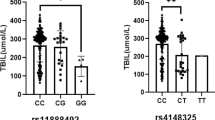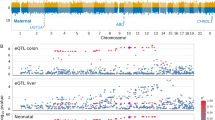Abstract
The incidence of severe neonatal hyperbilirubinemia is higher in Asians than in whites. A case-control study was designed to investigate the effects of eight known risk factors [breast feeding, ABO incompatibility, premature birth, infection, cephalohematoma, asphyxia, glucose-6-phosphate dehydrogenase (G6PD) deficiency, and variant UDP-glucuronosyltransferase 1A1 (UGT1A1) gene] and a suspicious analog [organic anion transporter 2 (OATP 2) gene] on severe hyperbilirubinemia in Taiwanese neonates. The 72 study subjects and 100 hospital control subjects consisted of neonates with peak serum bilirubin levels ≥342 μM and <256.5 μM, respectively. The PCR–restriction fragment length polymorphism method was applied to detect the UGT1A1, OATP 2, and G6PD genes. The results of multivariate logistic regressions, adjusted for covariates, revealed odds ratios (ORs) of 4.64 [95% confidence interval (CI): 2.25–9.57; p < 0.001], 3.36 (95% CI: 1.54–7.35; p = 0.002), and 3.02 (95% CI: 1.30–6.99; p = 0.010) for neonates who were fed with breast milk, and carry the variant UGT1A1 gene at nucleotide 211 and the variant OATP 2 gene at nucleotide 388, respectively. The ORs, adjusted for covariates, for the other six risk factors were not statistically significant. The ORs in neonates who had one, two, and three significant risk factors were 8.46 (95% CI: 2.75–34.48; p < 0.001), 22.0 (95% CI: 5.50–88.0; p < 0.001), and 88.0 (95% CI: 12.50–642.50; p < 0.001), respectively. In conclusion, neonates who carry the 211 and 388 variants in the UGT1A1 and OATP 2 genes, respectively, as well as feed with breast milk are at high risk to develop severe hyperbilirubinemia.
Similar content being viewed by others
Log in or create a free account to read this content
Gain free access to this article, as well as selected content from this journal and more on nature.com
or
Abbreviations
- CGH:
-
Cathay General Hospital
- CI:
-
confidence interval
- G6PD:
-
glucose-6-phosphate dehydrogenase
- OATP 2:
-
organic anion transporter 2
- OR:
-
odds ratio
- RFLP:
-
restriction fragment length polymorphism
- UGT1A1:
-
UDP-glucuronosyltransferase 1A1
References
Cui Y, Konig J, Leier I, Buchholz U, Keppler D 2001 Hepatic uptake of bilirubin and its conjugates by the human organic anion transporter SLC21A6. J Biol Chem 276: 9626–9630
Clarke DJ, Moghrabi N, Monaghan G, Cassidy A, Boxer M, Hume R, Burchell B 1997 Genetic defects of the UDP-glucuronosyltransferase 1 (UGT1) gene that cause familial non-hemolytic unconjugated hyperbilirubinaemias. Clin Chim Acta 266: 63–74
Ives NK 1999 Gastroenterology part 1. Neonatal jaundice. In: Rennie JM, Roberton NRC (eds) Textbook of Neonatology, 3rd Ed. Churchill- Livingston Edinburgh, pp 715–732
Halamek LP, Stevenson D 1997 Diseases of the fetus and infants. In: Fanaroff AA, Martin RJ (eds) Neonatal-Perinatal Medicine. Mosby, St. Louis, pp 1345–1389
Beutler E 1994 G6PD deficiency. Blood 84: 3616–3636
Yu MW, Hsiao KJ, Wuu KD, Chen CJ 1992 Association between glucose-6-phosphate dehydrogenase deficiency and neonatal jaundice: interaction with multiple risk factors. Int J Epidemiol 21: 947–952
Huang CS, Hung KL, Huang MJ, Li YC, Liu TH, Tang TK 1996 Neonatal jaundice and molecular mutations in glucose-6-phosphate dehydrogenase deficient newborn infants. Am J Hematol 51: 19–25
Bancroft JD, Kreamer B, Gourley GR 1998 Gilbert's syndrome accelerates development of neonatal jaundice. J Pediatr 132: 656–660
Monaghan G, McLellan A, McGeehan A, Li Volti S, Mollica F, Salemi I, Din Z, Cassidy A, Hume R, Burchell B 1999 Gilbert's syndrome is a contributory factor in prolonged unconjugated hyperbilirubinemia of the newborn. J Pediatr 134: 441–446
Akaba K, Kimura T, Sasaki A, Tanabe S, Ikegami T, Hashimoto M, Umeda H, Yoshida H, Umetsu K, Chiba H, Yuasa I, Hayasaka K 1998 Neonatal hyperbilirubinemia and mutation of the bilirubin uridine-diphosphate-glucuronosyltransferase gene: a common missense mutation among Japanese, Koreans and Chinese. Biochem Mol Biol Int 46: 21–26
Maruo Y, Nishizawa K, Sato H, Doida Y, Shimada M 1999 Association of neonatal hyperbilirubinemia with bilirubin UDP-glucuronosyltransferase polymorphism. Pediatrics 103: 1224–1227
Huang CS, Chang PF, Huang MJ, Chen ES, Hung KL 2002 Relationship between bilirubin UDP-glucuronosyl transferase 1A1 gene and neonatal hyperbilirubinemia. Pediatr Res 52: 601–605
Kaplan M, Renbaum P, Levy-Lahad E, Hammerman C, Lahad A, Beutler E 1997 Gilbert's syndrome and glucose-6-phosphate dehydrogenase deficiency: a dose-dependent genetic interaction crucial to neonatal hyperbilirubinemia. Proc Natl Acad Sci USA 94: 12128–12132
Galanello R, Cipollina MD, Carboni G, Perseu L, Barella S, Corrias A, Cao A 1999 Hyperbilirubinemia, glucose-6-phosphate dehydrogenase deficiency and Gilbert's syndrome. Eur J Pediatr 158: 914–916
Iolascon A, Faienza MF, Perrotta S, Meloni GF, Ruggiu G, del Giudice EM 1999 Gilbert's syndrome and jaundice in glucose-6-phosphate dehydrogenase deficient neonates. Haematologica 84: 99–102
Huang CS, Chang PF, Huang MJ, Chen ES, Chen WC 2002 Glucose-6-phosphate dehydrogenase deficiency, the UDP-glucuronosyl transferase 1A1 gene, and neonatal hyperbilirubinemia. Gastroenterology 123: 127–133
Tirona RG, Leake BF, Merino G, Kim RB 2001 Polymorphisms in OATP-C: identification of multiple allele variants associated with altered transport activity among European- and African-Americans. J Biol Chem 276: 35669–35675
Nozawa T, Nakajima M, Tami I, Noda K, Nezu J, Sai Y, Tsuji A, Yokoi T 2002 Genetic polymorphisms of human organic anion transporter OATP-C (SLC21A6) and OATP-B (SLC21A9): allele frequencies in the Japanese population and functional analysis. J Pharmacol Exp Ther 302: 804–813
Tang TK, Huang CS, Huang MJ, Tam KB, Yen CH, Tang CJ 1992 Diverse point mutations result in glucose-6-phosphate dehydrogenase (G6PD) polymorphism in Taiwan. Blood 79: 2135–2140
Lo YS, Lu CC, Chiou SS, Chen BH, Chang TT, Chang JG 1993 Molecular characterization of glucose-6- phosphate dehydrogenase deficiency in Chinese infants with or without severe neonatal hyperbilirubinemia. Br J Hematol 86: 858–862
Chen HL, Huang MJ, Huang CS, Tang TK 1997 Two novel glucose-6-phosphate dehydrogenase deficiency mutations and association of such mutations with F8C/G6PD haplotype in Chinese. J Formos Med Assoc 96: 948–954
Huang CS, Luo GA, Huang MJ, Yu SC, Yang SS 2000 Variations of the bilirubin uridine-diphosphoglucuronosyl transferase 1A1 gene in healthy Taiwanese. Pharmacogenetics 10: 539–544
Zaghloul H, Schulze KF 2001 Neonatal jaundice. In: Elzouki AY, Harfi HA, Nazer HM (eds) Textbook of Clinical Pediatrics. Lippincott Williams & Wilkins, Philadelphia, pp 207–214
Balram C, Sabapathy K, Fei G, Khoo KS, Lee EJ 2002 Genetic polymorphisms of UDP-glucuronosyltransferase in Asians: UGT1A1 *28 is a common allele in Indians. Pharmacogenetics 12: 81–83
Sato H, Adachi Y, Koiwai O 1996 The genetic basis of Gilbert's syndrome. Lancet 347: 557–558
Ando Y, Chida M, Nakayama K, Saka H, Kamataki T 1998 The UGT1A1 *28 allele is relatively rare in a Japanese population. Pharmacogenetics 8: 357–360
Bosma PJ, Chowdhury JR, Bakker CT, Gantla S, de Boer A, Oostra BA, Lindhout D, Tytgat GN, Jansen PL, Oude-Elferink RP, Chowdhury NR 1995 The genetic basis of the reduced expression of bilirubin UDP-glucuronosyltransferase 1 in Gilbert's syndrome. N Engl J Med 333: 1171–1175
Monaghan G, Ryan M, Seddon R, Hume R, Burchell B 1996 Genetic variation in bilirubin UDP-glucuronosyltransferase gene promoter and Gilbert's syndrome. Lancet 347: 578–581
Monaghan G, Foster B, Jurima-Romet M, Hume R, Burchell B 1997 UGT1 *1 genotyping in a Canadian Inuit population. Pharmacogenetics 7: 153–156
Beutler E, Gelbart T, Demina A 1998 Racial variability in the UDP-glucuronosyl- transferase 1 (UGT1A1) promoter: a balanced polymorphism for regulation of bilirubin metabolism?. Proc Natl Acad Sci USA 95: 8170–8174
Saeki M, Saito Y, Jinno H, Tohkin M, Kurose K, Kaniwa N, Komamura K, Ueno K, Kamakura S, Kitakaze M, Ozawa S, Sawada J 2003 Comprehensive UGT1A1 genotyping in a Japanese population by pyrosequencing. Clin Chem 49: 1182–1185
Maruo Y, Nishizawa K, Sato H, Sawa H, Shimada M 2000 Prolonged unconjugated hyperbilirubinemia associated with breast milk and mutations of the bilirubin uridine diphosphate-glucuronosyltransferase gene. Pediatrics 106: E59
Kaplan M, Hammerman C, Renbaum P, Klein G, Levy-Lahad E 2000 Gilbert's syndrome and hyperbilirubinemia in ABO incompatible neonates. Lancet 356: 652–653
Yamamoto K, Sato H, Fujiyama Y, Doida Y, Bamba T 1998 Contribution of two missense mutations (G71R and Y486D) of the bilirubin UDP glycosyltransferase (UGT1A1) gene to phenotypes of Gilbert's syndrome and Crigler-Najjar syndrome type II. Biochim Biophys Acta 1406: 267–273
Tamai I, Nezu J, Uchino H, Sai Y, Oku A, Shimane M, Tsuji A 2000 Molecular identification and characterization of novel members of the human organic anion transporter (OATP) family. Biochem Biophys Res Commun 273: 251–260
Wang P, Kim RB, Chowdhury JR, Wolkoff AW 2003 The human organic anion transport protein SLC21A6 is not sufficient for bilirubin transport. J Biol Chem 278: 20695–20699
Author information
Authors and Affiliations
Additional information
This study was supported by a grant from the National Science Council, Taiwan (contract no. NSC 92-3112-B-242-001).
Rights and permissions
About this article
Cite this article
Huang, MJ., Kua, KE., Teng, HC. et al. Risk Factors for Severe Hyperbilirubinemia in Neonates. Pediatr Res 56, 682–689 (2004). https://doi.org/10.1203/01.PDR.0000141846.37253.AF
Received:
Accepted:
Issue date:
DOI: https://doi.org/10.1203/01.PDR.0000141846.37253.AF
This article is cited by
-
UGT1A1 mutation association with increased bilirubin levels and severity of unconjugated hyperbilirubinemia in ABO incompatible newborns of China
BMC Pediatrics (2021)
-
The relationship between hyperbilirubinemia and the promoter region and first exon of UGT1A1 gene polymorphisms in Vietnamese newborns
Pediatric Research (2020)
-
UGT1A1 gene and neonatal hyperbilirubinemia: a preliminary study from Bengkulu, Indonesia
BMC Research Notes (2018)
-
Clinical evaluation of severe neonatal Hyperbilirubinaemia in a resource-limited setting: a 4-year longitudinal study in south-East Nigeria
BMC Pediatrics (2018)
-
Risk assessment of prolonged jaundice in infants at one month of age: A prospective cohort study
Scientific Reports (2018)



